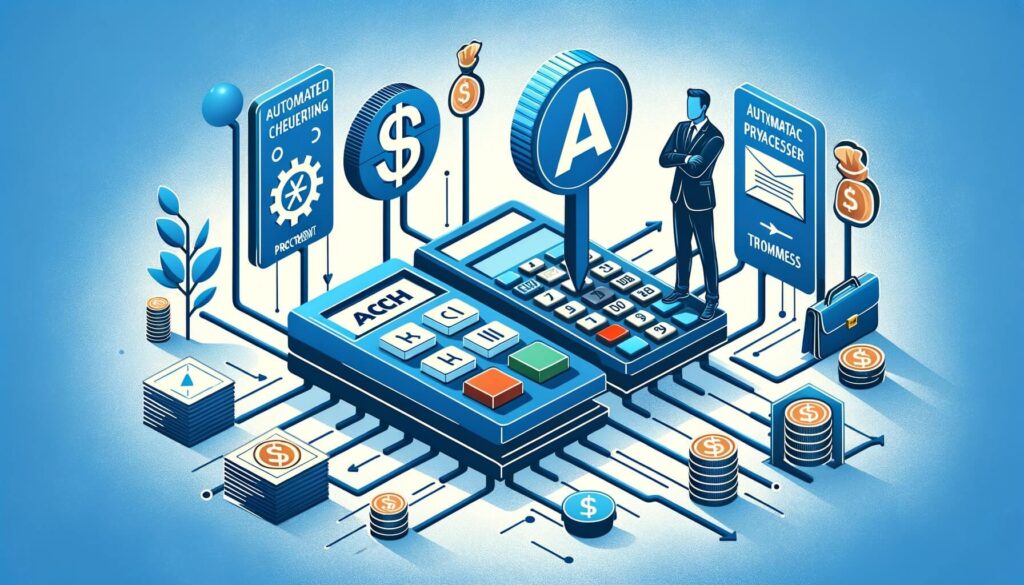
By Ava Owen April 22, 2025
In today’s digital age, electronic payments have become the norm for businesses and consumers alike. One popular method of electronic payment is the Automated Clearing House (ACH) system. ACH payments offer a convenient and secure way to transfer funds between bank accounts, making them an essential tool for businesses of all sizes. In this article, we will explore what ACH payments are, how they work, and why businesses should consider using them.
ACH stands for Automated Clearing House, which is a network that facilitates electronic funds transfers in the United States. It is managed by the National Automated Clearing House Association (NACHA), a non-profit organization that sets the rules and standards for ACH transactions. ACH payments are commonly used for direct deposit of payroll, vendor payments, and recurring bill payments.
How ACH Transactions Work: A Step-by-Step Guide

To understand how ACH transactions work, let’s walk through a step-by-step guide:
Step 1: Authorization – The first step in an ACH transaction is obtaining authorization from the account holder. This can be done through various methods, such as a signed authorization form, an online consent, or a recorded phone conversation.
Step 2: Initiation – Once authorization is obtained, the payment initiator, which can be a business or an individual, initiates the ACH transaction. They provide the necessary information, including the recipient’s bank account number, routing number, and the amount to be transferred.
Step 3: Transmission – The payment initiator’s financial institution transmits the ACH file to the ACH operator, which is responsible for processing and settling the transactions. The ACH operator sorts the transactions and sends them to the respective receiving financial institutions.
Step 4: Receiving Financial Institution – The receiving financial institution receives the ACH file and processes the transactions. They verify the account information, check for sufficient funds, and credit or debit the appropriate accounts accordingly.
Step 5: Settlement – After the transactions are processed, the receiving financial institution sends an acknowledgment to the ACH operator, confirming the successful completion of the transactions. The ACH operator then settles the funds between the sending and receiving financial institutions.
The Advantages of ACH Payments: Why Businesses Should Consider Using Them

There are several advantages to using ACH payments for businesses:
1. Cost-Effective: ACH payments are typically more cost-effective than traditional payment methods, such as checks or wire transfers. Businesses can save on printing and mailing costs, as well as reduce the risk of lost or stolen checks.
2. Efficiency: ACH payments are faster and more efficient than paper-based transactions. Funds can be transferred electronically, eliminating the need for manual processing and reducing the time it takes to complete a transaction.
3. Security: ACH payments are highly secure, with multiple layers of encryption and authentication protocols in place. This helps protect sensitive financial information and reduces the risk of fraud or unauthorized access.
4. Convenience: ACH payments offer convenience for both businesses and customers. Recurring payments can be set up, eliminating the need for manual payment processing each time. Customers can also choose to receive electronic statements and notifications, further streamlining the payment process.
5. Improved Cash Flow: ACH payments can help improve cash flow for businesses. With faster settlement times, businesses can receive funds more quickly, allowing for better management of cash flow and working capital.
ACH Payment Processors: Choosing the Right Provider for Your Business

When it comes to processing ACH payments, businesses have the option to work with ACH payment processors. These processors act as intermediaries between the business and the ACH network, handling the technical aspects of the payment process. When choosing an ACH payment processor, there are several factors to consider:
1. Reliability and Security: It is crucial to choose a reputable ACH payment processor that prioritizes security and has robust fraud prevention measures in place. Look for processors that are compliant with industry standards, such as Payment Card Industry Data Security Standard (PCI DSS) and have a proven track record of protecting customer data.
2. Integration and Compatibility: Consider the compatibility of the ACH payment processor with your existing systems and software. Look for processors that offer seamless integration with popular accounting and payment platforms, making it easier to manage and reconcile transactions.
3. Pricing Structure: Compare the pricing structures of different ACH payment processors. Some processors charge a flat fee per transaction, while others may have a tiered pricing structure based on transaction volume. Consider your business’s transaction volume and choose a pricing structure that aligns with your needs.
4. Customer Support: Evaluate the level of customer support provided by the ACH payment processor. Look for processors that offer 24/7 support and have a dedicated team to assist with any technical or operational issues that may arise.
5. Additional Features: Consider any additional features or services offered by the ACH payment processor. Some processors may offer value-added services, such as real-time reporting, customizable payment pages, or advanced analytics, which can enhance the payment experience for both businesses and customers.
A Closer Look at ACH Payment Authorization and Security Measures

ACH payment authorization is a critical step in the payment process, ensuring that funds are transferred securely and with the account holder’s consent. There are several security measures in place to protect against unauthorized transactions and fraud:
1. Account Verification: Before initiating an ACH payment, businesses must verify the account information provided by the customer. This includes verifying the account number, routing number, and account holder’s name. This helps ensure that the funds are being transferred to the correct recipient.
2. Authorization Forms: Businesses often require customers to sign authorization forms, granting permission to initiate ACH transactions. These forms outline the terms and conditions of the payment, including the frequency, amount, and duration of the payments. The signed forms serve as proof of authorization and can be used to resolve any disputes that may arise.
3. Two-Factor Authentication: Some ACH payment processors offer two-factor authentication, adding an extra layer of security to the payment process. This typically involves sending a unique code to the account holder’s mobile device or email, which must be entered to confirm the transaction.
4. Encryption and Data Security: ACH payment processors use encryption technology to protect sensitive financial information during transmission. This ensures that the data is securely transmitted and cannot be intercepted or accessed by unauthorized parties.
5. Fraud Monitoring and Prevention: ACH payment processors employ sophisticated fraud monitoring and prevention systems to detect and prevent fraudulent transactions. These systems analyze transaction patterns, identify suspicious activity, and flag potentially fraudulent transactions for further investigation.
A Comprehensive Guide to ACH Payment Processing Fees and Costs
When it comes to ACH payment processing, businesses should be aware of the fees and costs associated with the service. While ACH payments are generally more cost-effective than other payment methods, there are still fees involved. Here is a breakdown of the common fees and costs associated with ACH payment processing:
1. Transaction Fees: ACH payment processors typically charge a transaction fee for each ACH payment processed. This fee can be a flat rate per transaction or a percentage of the transaction amount. The transaction fee may vary depending on the volume of transactions processed.
2. Monthly Fees: Some ACH payment processors charge a monthly fee for access to their services. This fee covers the cost of maintaining the payment processing platform and providing customer support.
3. Setup Fees: In some cases, ACH payment processors may charge a one-time setup fee to onboard new businesses onto their platform. This fee covers the cost of setting up the necessary infrastructure and integrating with the business’s existing systems.
4. Return Fees: If an ACH payment is returned due to insufficient funds or other reasons, the payment processor may charge a return fee. This fee covers the cost of processing the return and handling any associated administrative tasks.
5. Chargeback Fees: In the event of a dispute or fraudulent transaction, the payment processor may charge a chargeback fee. This fee covers the cost of investigating and resolving the dispute, as well as any associated administrative tasks.
It is important for businesses to carefully review the fee structure of different ACH payment processors and choose a provider that offers transparent pricing and competitive rates. Consider the overall value provided by the processor, including the quality of service, security measures, and additional features, in addition to the fees and costs.
ACH Payment Settlement: Timelines and Considerations
ACH payment settlement refers to the process of transferring funds between the sending and receiving financial institutions. The settlement timeline for ACH payments can vary depending on several factors:
1. Batch Processing: ACH payments are typically processed in batches, which are submitted at specific times throughout the day. The settlement timeline can depend on when the batch is submitted and the cut-off times set by the financial institutions involved.
2. Standard Settlement: The standard settlement timeline for ACH payments is typically one to two business days. This means that funds are usually available in the recipient’s account within one to two business days after the payment is initiated.
3. Same-Day ACH: In 2016, NACHA introduced same-day ACH, which allows for faster settlement of ACH payments. With same-day ACH, funds can be made available in the recipient’s account on the same business day as the payment is initiated. However, same-day ACH may come with additional fees, and not all financial institutions support this option.
4. Weekends and Holidays: ACH payments are not processed on weekends or federal holidays. If a payment is initiated on a Friday or a day before a holiday, the settlement timeline may be extended accordingly.
When considering the settlement timeline for ACH payments, businesses should take into account their cash flow needs and the urgency of the payment. If immediate availability of funds is required, same-day ACH or alternative payment methods, such as wire transfers, may be more suitable.
ACH Payments vs. Other Payment Methods: A Comparative Analysis
ACH payments offer several advantages over traditional payment methods, such as checks or wire transfers. Let’s compare ACH payments to other payment methods to understand their relative strengths and weaknesses:
1. ACH Payments vs. Checks: ACH payments are faster and more efficient than checks. While checks require manual processing and can take several days to clear, ACH payments can be settled within one to two business days. ACH payments also eliminate the risk of lost or stolen checks and offer better security through encryption and authentication measures.
2. ACH Payments vs. Wire Transfers: ACH payments are generally more cost-effective than wire transfers. Wire transfers often come with higher fees, especially for international transfers, whereas ACH payments have lower transaction costs. However, wire transfers offer immediate availability of funds, making them suitable for urgent or high-value transactions.
3. ACH Payments vs. Credit/Debit Cards: ACH payments and credit/debit cards serve different purposes. Credit/debit cards offer convenience and immediate availability of funds, but they come with higher transaction fees for businesses. ACH payments are more cost-effective for recurring payments or large transactions, but they may not be suitable for point-of-sale transactions or online purchases.
4. ACH Payments vs. Digital Wallets: Digital wallets, such as PayPal or Apple Pay, offer a convenient way to make online payments. However, they often come with higher transaction fees compared to ACH payments. ACH payments are better suited for recurring payments or business-to-business transactions, where lower transaction costs are a priority.
When choosing a payment method, businesses should consider their specific needs, transaction volume, and cost considerations. ACH payments offer a balance between cost-effectiveness, security, and efficiency, making them a popular choice for many businesses.
Common FAQs About ACH Payments: Answering Your Burning Questions
Q1. What is the difference between ACH and wire transfer?
Answer: ACH payments and wire transfers are both electronic payment methods, but they differ in terms of cost, speed, and availability of funds. ACH payments are generally more cost-effective and have a longer settlement timeline of one to two business days. Wire transfers, on the other hand, are faster and offer immediate availability of funds, but they come with higher fees.
Q2. Are ACH payments secure?
Answer: Yes, ACH payments are secure. ACH payment processors use encryption technology and authentication measures to protect sensitive financial information. Additionally, businesses must obtain authorization from the account holder before initiating an ACH payment, adding an extra layer of security.
Q3. Can ACH payments be reversed?
Answer: ACH payments can be reversed in certain circumstances. If there is an error in the payment, such as an incorrect amount or an unauthorized transaction, businesses can initiate a reversal or a return. However, there are specific rules and timeframes for initiating reversals, and businesses should consult their ACH payment processor for guidance.
Q4. Can ACH payments be used for international transactions?
Answer: ACH payments are primarily used for domestic transactions within the United States. For international transactions, businesses may need to use alternative payment methods, such as wire transfers or international ACH transfers (IATs), which have additional requirements and fees.
Q5. Can ACH payments be used for point-of-sale transactions?
Answer: ACH payments are not typically used for point-of-sale transactions, as they require the account holder’s authorization and have a longer settlement timeline. Point-of-sale transactions are usually processed using credit/debit cards or digital wallets, which offer immediate availability of funds.
Conclusion
ACH payments have revolutionized the way businesses transfer funds electronically. With their cost-effectiveness, efficiency, and security, ACH payments offer numerous advantages over traditional payment methods.
By understanding the basics of ACH payments, how they work, and the considerations involved, businesses can make informed decisions about incorporating ACH payments into their payment processes. Whether it’s for payroll, vendor payments, or recurring bill payments, ACH payments provide a reliable and convenient solution for businesses of all sizes.